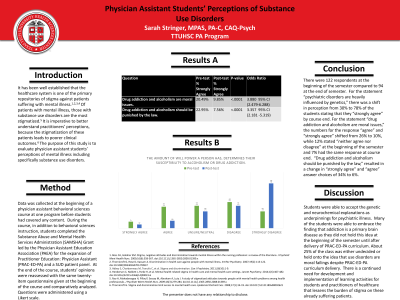Back


Introduction: It has been well established that the healthcare system is one of the primary repositories of stigma against patients suffering with mental illness.1,2,3,4 Of patients with mental illness, those with substance use disorders are the most stigmatized.5 It is imperative to better understand practitioners’ perceptions, because the stigmatization of these patients leads to poorer clinical outcomes.6 The purpose of this study is to evaluate physician assistant students’ perceptions of mental illness including specifically substance use disorders.
Methods: Data was collected at the beginning of a physician assistant behavioral sciences course at one program before students had covered any content. During the course, in addition to behavioral sciences instruction, students completed the Substance Abuse and Mental Health Services Administration (SAMSHA) Grant led by the Physician Assistant Education Association (PAEA) for the expansion of Practitioner Education: Physician Assistant (PRAC-ED-PA). At the end of the course, students’ opinions were reassessed with the same twenty item questionnaire given at the beginning of the course and comparatively analyzed. Questions were administered using a Likert scale.
Results: There were 61 respondents at the beginning of the semester compared to 57 at the end of semester. For the statement “psychiatric disorders are heavily influenced by genetics,” there was a shift in perception from 27.87% to 77.19% of the students stating that they “strongly agree” by course end. For the statement “drug addiction and alcoholism are moral issues,” the numbers for the response “agree” and “strongly agree” shifted from 29.51% to 14.29%, while 24.59 % stated “neither agree nor disagree” at the beginning of the semester and 12.5% had the same response at course end. “Drug addiction and alcoholism should be punished by the law,” resulted in a change in “strongly agree” and “agree” answer choices of 34.43% to 7.01%.
Discussion: Students were able to accept the genetic and neurochemical explanations as underpinnings for psychiatric illness. Many of the students were able to embrace the finding that addiction is a primary brain disease as did not hold this idea at the beginning of the semester until after delivery of PRAC-ED-PA curriculum. About 25% of the class was either undecided or held onto the idea that use disorders are moral failings despite PRAC-ED-PA curriculum delivery. There is a continued need for development and implementation of learning activities for students and practitioners of healthcare that lessens the burden of stigma on these already suffering patients.
References: 1. Ross, C.A., & Goldner, E.M. (2009). Stigma, negative attitudes and discrimination towards mental illness within the nursing profession: A review of the literature. Journal of Psychiatric and Mental Health Nursing, 16 (6), 558-567.
2. Thornicroft, G., Rose, D., & Kassam, A. (2007) Discrimination in healthcare against people with mental illness. International Review of Psychiatry, 19(2), 113-122.
3. Abbey S, Charbonneau M, Tranulis C, Moss P, Baici W, Dabby L, Gautam M, Paré M. Stigma and discrimination. Can J Psychiatry. 2011 Oct;56(10):1-9.
4. Henderson C, Noblett J, Parke H, Clement S, Caffrey A, Gale-Grant O, Schulze B, Druss B, Thornicroft G. Mental health-related stigma in health care and mental health-care settings. Lancet Psychiatry. 2014 Nov;1(6):467-82.
5. Rao H, Mahadevappa H, Pillay P, Sessay M, Abraham A, Luty J. A study of stigmatized attitudes towards people with mental health problems among health professionals. J Psychiatr Ment Health Nurs. 2009 Apr;16(3):279-84.
6. Thornicroft, G. (2006). Stigma and discrimination limit access to mental healthcare. Epidemiologia e Psichiatria Sociale, 17(1), 14-19.
Diversity, Equity, and Inclusion: This presentation is about equitable treatment and care of persons with substance use disorders, encouraged by decreasing stigma of persons with mental illness and use disorders among graduate healthcare education students. Some of the greatest healthcare disparities are among those suffering from addiction, much of which is due to stigma.
(97) Physician Assistant Students’ Perceptions of Substance Use Disorders
Saturday, April 2, 2022
10:00 AM – 11:30 AM ET
Location: Great Hall Foyer, Third Floor

Has Audio

Sarah Stringer, MPAS, PA-C
Assistant Professor
Texas Tech University Health Sciences Center, Texas
Presenter(s)
Introduction: It has been well established that the healthcare system is one of the primary repositories of stigma against patients suffering with mental illness.1,2,3,4 Of patients with mental illness, those with substance use disorders are the most stigmatized.5 It is imperative to better understand practitioners’ perceptions, because the stigmatization of these patients leads to poorer clinical outcomes.6 The purpose of this study is to evaluate physician assistant students’ perceptions of mental illness including specifically substance use disorders.
Methods: Data was collected at the beginning of a physician assistant behavioral sciences course at one program before students had covered any content. During the course, in addition to behavioral sciences instruction, students completed the Substance Abuse and Mental Health Services Administration (SAMSHA) Grant led by the Physician Assistant Education Association (PAEA) for the expansion of Practitioner Education: Physician Assistant (PRAC-ED-PA). At the end of the course, students’ opinions were reassessed with the same twenty item questionnaire given at the beginning of the course and comparatively analyzed. Questions were administered using a Likert scale.
Results: There were 61 respondents at the beginning of the semester compared to 57 at the end of semester. For the statement “psychiatric disorders are heavily influenced by genetics,” there was a shift in perception from 27.87% to 77.19% of the students stating that they “strongly agree” by course end. For the statement “drug addiction and alcoholism are moral issues,” the numbers for the response “agree” and “strongly agree” shifted from 29.51% to 14.29%, while 24.59 % stated “neither agree nor disagree” at the beginning of the semester and 12.5% had the same response at course end. “Drug addiction and alcoholism should be punished by the law,” resulted in a change in “strongly agree” and “agree” answer choices of 34.43% to 7.01%.
Discussion: Students were able to accept the genetic and neurochemical explanations as underpinnings for psychiatric illness. Many of the students were able to embrace the finding that addiction is a primary brain disease as did not hold this idea at the beginning of the semester until after delivery of PRAC-ED-PA curriculum. About 25% of the class was either undecided or held onto the idea that use disorders are moral failings despite PRAC-ED-PA curriculum delivery. There is a continued need for development and implementation of learning activities for students and practitioners of healthcare that lessens the burden of stigma on these already suffering patients.
References: 1. Ross, C.A., & Goldner, E.M. (2009). Stigma, negative attitudes and discrimination towards mental illness within the nursing profession: A review of the literature. Journal of Psychiatric and Mental Health Nursing, 16 (6), 558-567.
2. Thornicroft, G., Rose, D., & Kassam, A. (2007) Discrimination in healthcare against people with mental illness. International Review of Psychiatry, 19(2), 113-122.
3. Abbey S, Charbonneau M, Tranulis C, Moss P, Baici W, Dabby L, Gautam M, Paré M. Stigma and discrimination. Can J Psychiatry. 2011 Oct;56(10):1-9.
4. Henderson C, Noblett J, Parke H, Clement S, Caffrey A, Gale-Grant O, Schulze B, Druss B, Thornicroft G. Mental health-related stigma in health care and mental health-care settings. Lancet Psychiatry. 2014 Nov;1(6):467-82.
5. Rao H, Mahadevappa H, Pillay P, Sessay M, Abraham A, Luty J. A study of stigmatized attitudes towards people with mental health problems among health professionals. J Psychiatr Ment Health Nurs. 2009 Apr;16(3):279-84.
6. Thornicroft, G. (2006). Stigma and discrimination limit access to mental healthcare. Epidemiologia e Psichiatria Sociale, 17(1), 14-19.
Diversity, Equity, and Inclusion: This presentation is about equitable treatment and care of persons with substance use disorders, encouraged by decreasing stigma of persons with mental illness and use disorders among graduate healthcare education students. Some of the greatest healthcare disparities are among those suffering from addiction, much of which is due to stigma.
